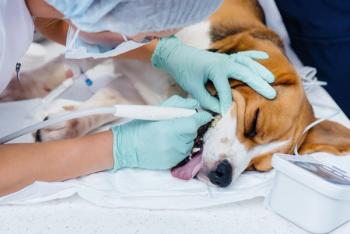
Making the case for laser therapy in veterinary rehabilitation

DIVM keynote speaker brings emerging modality into focus
The inaugural Directions in Veterinary Medicine conference in Indianapolis, Indiana, launched today with an insightful keynote session by Matthew Brunke, DVM, DACVSMR, CCRP, CVPP, CVA, medical director for rehabilitation and sports medicine at Veterinary Surgical Centers in Virginia. His lecture “Laser therapy in veterinary rehabilitation” examined the role lasers can play as a fast, efficient treatment option for an emerging practice that is rapidly becoming the standard of care, according to Brunke.1
At the heart of laser therapy is the concept of photobiomodulation (PBM), which Brunke said is how lasers can be used to increase the speed, quality, and tensile strength of tissue repair; resolve inflammation; and relieve pain.1 PBM is the process by which photons penetrate tissue, increasing adenosine triphosphate (ATP) production in cells and stimulating wound healing while reducing pain and inflammation.2
“Photobiomodulation is basically the mechanism of action of therapeutic lasers in our field,” said Brunke. “It’s that nonthermal interaction with a monochromatic light with a target site.”
Rehabilitation at lightspeed
Rehabilitative treatment is aimed at restoring quality of life to patients suffering from painful and/or functionally limiting musculoskeletal and neurologic conditions. It is already a multimodal discipline, with a diverse array of treatment options such as acupuncture, hydrotherapy, shock wave therapy, massage, and therapeutic exercise. Through advances in technology and research in recent years, said Brunke, veterinary professionals can now comfortably add lasers to their rehabilitation toolbox. In making the case for the use of lasers in veterinary practice, Brunke shared published research and case studies that emphasized their versatility and ease of use in treating inflammation and pain, allowing many types of patients to recover faster and more effectively.1
The right tool for the right job
Not all lasers are created equal. Brunke explained that different classes of therapeutic lasers produce different wavelengths of light, and different wavelength ranges have varying effects on tissue. He used the term “photoceutical” to describe laser therapy throughout the presentation to drive home the concept that clinicians are essentially prescribing a particular laser treatment for a particular condition.
“If we want antibacterial effects, we want wavelengths of 460 nm,” Brunke explained. “As far as wound healing, we need something in the 600 to 800 range. We can also use a 980 nm wavelength for analgesic effects, with some anti-inflammatory [effects].”
He cautioned that it is important to use the appropriate laser and wavelength for a particular condition. Because each wavelength differs in its effects, using the incorrect laser is not only ineffective, but can potentially hurt the patient as well. “That's nothing any of us want to do in our careers,” Brunke remarked.
Indications for laser therapy
Brunke discussed the diagnoses that lasers can be used to treat. These include neurological diagnoses, such as intervertebral disc disease, degenerative myelopathy, and peripheral nerve disease. It also includes tissue healing and orthopedic diagnoses, such as osteoarthritis and tendon, ligament, and muscle injuries.1
He also gave examples and case studies of conditions that could benefit from the pain reduction and anti-inflammatory benefits of laser therapy as a sole treatment modality, which included surgical incisions, wounds, lick granulomas, otitis externa, osteoarthritis, and tail pull injuries.1 However, Brunke emphasized the value of laser therapy as part of a multimodal approach:
“We may use a little bit of surgery in our [practice]… We need some pharmaceutical assistance, too… We all have the same receptors, but our bodies may use them differently. So, we have to use a multimodal approach,” he said.
“What it boils down to is we treat inflammation, and we treat pain… Because if we don't get those going, we can't move that patient forward,” Brunke added.
References
- Brunke M. Laser therapy in veterinary rehabilitation. Presented at: Directions in Veterinary Medicine; June 24-25, 2022; Indianapolis, Indiana.
- Glass GE. Photobiomodulation: The Clinical Applications of Low-Level Light Therapy [published correction appears in Aesthet Surg J. 2022 Apr 12;42(5):566]. Aesthet Surg J. 2021;41(6):723-738. doi:10.1093/asj/sjab025
Newsletter
From exam room tips to practice management insights, get trusted veterinary news delivered straight to your inbox—subscribe to dvm360.




